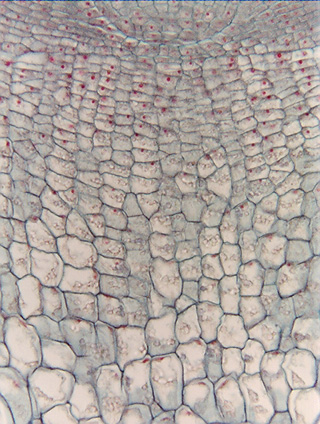 Fig.
6.8-2c. Magnification of the columella mother cells and columella of
a root cap of cattail. Notice the white, refractile particles in the columella
cells -- those are starch grains called statoliths. They are dense enough to
sink to through cytoplasm to the lower side of the cell, indicating which
direction is "down." Cells that contain statoliths are called statocytes.
These statocytes were produced by cell divisions in the columella mother cells,
then were pushed forward by the production of even more cells from the columella
mother cells. As they are being pushed forward they differentiate into
statocytes, and then will (in many species at least) begin secreting a slimy
mucilage that lubricates the root's passage through the soil. After that, the
cells will be crushed between the growing root and the surrounding soil -- these
cells live only briefly, just hours in some species.
Fig.
6.8-2c. Magnification of the columella mother cells and columella of
a root cap of cattail. Notice the white, refractile particles in the columella
cells -- those are starch grains called statoliths. They are dense enough to
sink to through cytoplasm to the lower side of the cell, indicating which
direction is "down." Cells that contain statoliths are called statocytes.
These statocytes were produced by cell divisions in the columella mother cells,
then were pushed forward by the production of even more cells from the columella
mother cells. As they are being pushed forward they differentiate into
statocytes, and then will (in many species at least) begin secreting a slimy
mucilage that lubricates the root's passage through the soil. After that, the
cells will be crushed between the growing root and the surrounding soil -- these
cells live only briefly, just hours in some species.